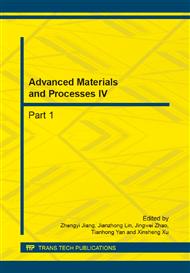[1]
I.V. Astahov, Prostranstvennaya ustoychivost elementov konstruktsiy iz holodnognutyih profiley, St. -Petersburg, 2006, 123p.
Google Scholar
[2]
A.G. Belyiy, Deformatsionnyiy raschet i ustoychivost tonkostennyih prizmaticheskih sterzhney proizvolnogo profilya szhatyih s dvuhosnyim ekstsentrisitetom, Dissertation for the degree of Doctor of Science in Technology, St. -Petersburg, 2000, 114p.
Google Scholar
[3]
G.I. Belyiy, Osobennosti rabotyi sterzhnevyih elementov konstruktsiy iz otsinkovannyih gnutyih profiley, Vestnik grazhdanskih inzhenerov 3(2012) pp.99-103.
Google Scholar
[4]
V.Z. Vlasov, Izbrannyie trudyi T. 2, Moskow, AN SSSR, 1963, 507p.
Google Scholar
[5]
V.Z. Vlasov, Tonkostennyie uprugie sterzhni (prochnost, ustoychivost, kolebaniya), Moskow, Stroyizdat, 1940, 276p.
Google Scholar
[6]
G.A. Gurvits, Izgib i ustoychivost nelineyno-deformiruemyih plastinchatyih sistem, Moskow, 1985, 136p.
Google Scholar
[7]
A. Yu. Kuznetsov, Prochnost i prostranstvennaya ustoychivost sostavnyih sterzhnevyih elementov konstruktsiy iz holodnognutyih profiley, Dissertation for the degree of Doctor of Science in Technology, St. -Petersburg, 2013, 175p.
Google Scholar
[8]
N.A. Kuzmin, P.A. Lukash, I.E. Mileykovskiy, Raschet konstruktsiy iz tonkostennyih sterzhney i obolochek, Moskow, Gosstroyizdat, 1960, 264p.
Google Scholar
[9]
A.V. Perelmuter, V.I. Slivker, Ustoychivost ravnovesiya konstruktsiy i rodstvennyie problemyi, Moskow, SCAD Soft, 2011, 388p.
Google Scholar
[10]
A.V. Perelmuter, V.I. Slivker, Raschetnyie modeli sooruzheniy i vozmozhnost ih analiza, Moskow, DMK Press, 2002, 618p.
Google Scholar
[11]
A.V. Perelmuter, V.V. Yurchenko, O raschete prostranstvennyih konstruktsiy iz tonkostennyih sterzhney otkryitogo profilya, Stroitelnaya mehanika i raschet sooruzheniy 6(2012) pp.18-25.
Google Scholar
[12]
V.V. Yurchenko, Proektirovanie karkasov zdaniy iz tonkostennyih holodnognutyih profiley v srede «SCAD Office», Inzhenerno-stroitelnyiy zhurnal 8(2010) pp.38-46.
Google Scholar
[13]
D. Dubina, V. Ungureanu, I. Szabo, Codification of imperfections for advanced finite analysis of cold-formed steel members, Proceedings of the 3rd ICTWS (2001) pp.179-186.
DOI: 10.1016/b978-008043955-6/50017-3
Google Scholar
[14]
P. Keerthan, M. Mahendran, Thermal performance of load bearing cold-formed steel walls under fire conditions using Numerical studies, Journal of Constructional Steel Research 80(2013) pp.412-428.
DOI: 10.1260/2040-2317.5.3.261
Google Scholar
[15]
W.T. Koiter, The effective width of flat plates for various longitudinal edge conditions at loads far beyond the buckling load, Rep. №5287, National Luchtvaart Laboratorium (2012) pp.365-374.
Google Scholar
[16]
C.N. Louise, A.M. Md Othuman, M. Ramli, Performance of lightweight thin-walled steel sections: theoretical and mathematical considerations, Applied Science Research 3(5), 2012, pp.2847-2859.
Google Scholar
[17]
N.I. Vatin, T. Nazmeeva, R. Guslinscky, Problems of cold-bent notched c-shaped profile members, Advanced Materials Research Vols. 941-944 (2014), pp.1871-1875.
DOI: 10.4028/www.scientific.net/amr.941-944.1871
Google Scholar
[18]
N.I. Vatin, J. Havula, L. Martikainen, A. Sinelnikov, A. Orlova, S. Salamakhin, Thin-walled cross-sections and their joints: tests and FEM-modelling, Advanced Materials Research Vols. 945-949 (2014), pp.1211-1215.
DOI: 10.4028/www.scientific.net/amr.945-949.1211
Google Scholar
[19]
V. Lalin, V. Rybakov, A. Sergey, The Finite Elements for Design of Frame of Thin-Walled Beams, Applied Mechanics and Materials Vols. 578-579 (2014) pp.858-863 (www. scientific. net/AMM. 578-579. 858).
DOI: 10.4028/www.scientific.net/amm.578-579.858
Google Scholar
[20]
V.A. Rybakov, Primeneniye polusdvigovoy teorii V.I. Slivkera dlya analiza napryazhenno-deformirovannogo sostoyaniya sistem tonkostennykh sterzhney. Diss. na soisk. uchen. step. k. t. n.: Spets. 01. 02. 04. S-Pb., 2012. 184 p.
Google Scholar
[21]
P.N. Nedviga, V.A. Rybakov, Empiricheskiye metody otsenki nesushchey sposobnosti stalnykh tonkostennykh prosechno-perforirovannykh balok i balok so sploshnoy stenkoy / Inzhenerno-stroitelnyy zhurnal. 2009. № 8(10). pp.27-30.
Google Scholar
[22]
M.V. Antonova , D.V. Glushko, S.V. Belyaeva, L. Pakrastinsh, A comparative analysis of European and Russian technical documentation of building materials, Construction of Unique Buildings and Structures, 4(19), 2014, pp.34-50.
Google Scholar
[23]
A. Kaklauskas, J. Naimaviciene, M. Krutinis, D. Venskus, E.K. Zavadskas, V. Plakys, Model for a complex analysis of intelligent built environment, Automation in construction, 3(2010), pp.326-340.
DOI: 10.1016/j.autcon.2009.12.006
Google Scholar
[24]
D. Nemova, V. Murgul, A. Golik, E. Chizhov, V. Pukhkal, N. Vatin: Reconstruction of administrative buildings of the 70s: the possibility of energy modernization. Journal of Applied Engineering Science, Vol. 12 (1), (2014), pp.37-44.
DOI: 10.5937/jaes12-5610
Google Scholar
[25]
V. Murgul: Features of energy efficient upgrade of historic buildings (illustrated with the example of Saint-Petersburg). Journal of Applied Engineering Science, Vol. 12 (1) (2014), pp.1-10.
DOI: 10.5937/jaes12-5609
Google Scholar
[26]
V. Murgul: Solar energy systems in the reconstruction of heritage historical buildings of the northern towns (for example Sankt-Petersburg). Journal of Applied Engineering Science, Vol. 12 (2) (2014), pp.121-128.
DOI: 10.5937/jaes12-6136
Google Scholar
[27]
S. Golovina, V. Murgul: Solar energy systems in the architecture of historic cities. Bulletin of Civil Engineers. 5 (40) (2013), pp.26-31.
Google Scholar
[28]
D. Vuksanovic, V. Murgul, N. Vatin, E. Aronova: Shadowing impact on amount of power generated by photovoltaic modules. Applied Mechanics and Materials. Vols. 587-589 (2014), pp.342-347.
DOI: 10.4028/www.scientific.net/amm.587-589.342
Google Scholar


